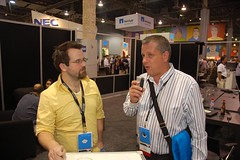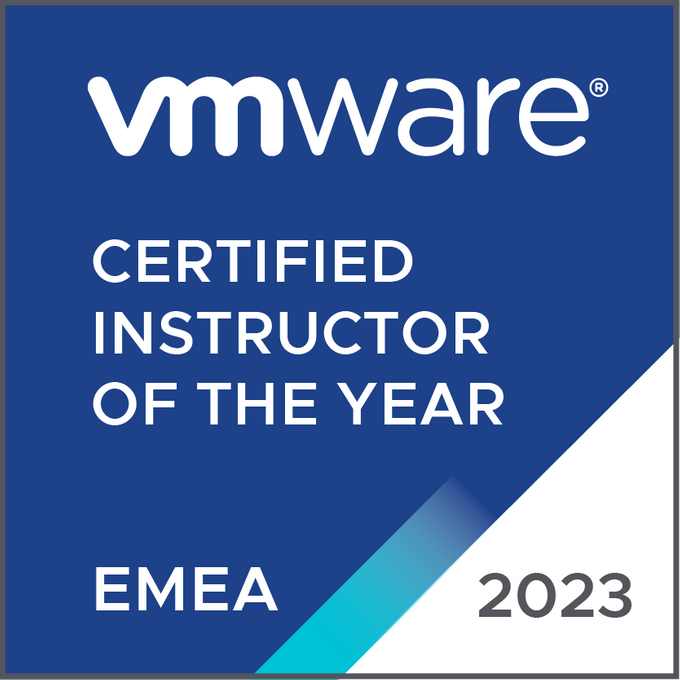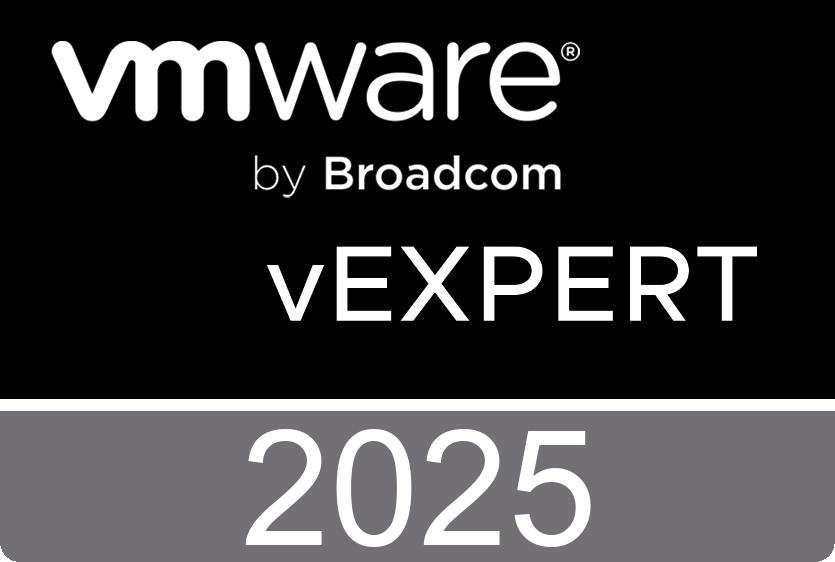 The Virtualization EcoShell Initiative (VESI) is a freeware development program that aims to enhance the virtualization administrative experience. Scott Herold has released the (private) alpha version yesterday, the public beta can be expected mid-April. To read the details about the Virtualization EcoShell – a Vizioncore freeware graphical toolkit, powered by Quest - click here.
The Virtualization EcoShell Initiative (VESI) is a freeware development program that aims to enhance the virtualization administrative experience. Scott Herold has released the (private) alpha version yesterday, the public beta can be expected mid-April. To read the details about the Virtualization EcoShell – a Vizioncore freeware graphical toolkit, powered by Quest - click here.
Tuesday, March 31. 2009
Don't forget to check out VESI
 The Virtualization EcoShell Initiative (VESI) is a freeware development program that aims to enhance the virtualization administrative experience. Scott Herold has released the (private) alpha version yesterday, the public beta can be expected mid-April. To read the details about the Virtualization EcoShell – a Vizioncore freeware graphical toolkit, powered by Quest - click here.
The Virtualization EcoShell Initiative (VESI) is a freeware development program that aims to enhance the virtualization administrative experience. Scott Herold has released the (private) alpha version yesterday, the public beta can be expected mid-April. To read the details about the Virtualization EcoShell – a Vizioncore freeware graphical toolkit, powered by Quest - click here.
VMware ESX Server 3.5 Update 4 is out there
- Newly Supported Management Agents
- Newly Supported Guest Operating Systems
- LSI megaraid_sas and mptscsi Storage Controller Driver Update
- Enablement of Intel Xeon Processor 5500 Series
- Expanded Support for Enhanced vmxnet Adapter
- Intel ICH9
- Intel ICH10
VMware ESX Server 3.5 Update 4 Release Notes
ESX 3.5 supports multiple SATA controllers. Some of these controllers are supported only in the native Advanced Host Controller Interface (AHCI)/SATA mode with SATA hard-drive, and some are only supported in IDE/ATA mode with SATA Optical Drive. For other controllers, VMware provides support in AHCI/SATA or IDE/ATA mode on both types of drives, but you need to be aware of certain feature limitations and trade-offs associated with each mode.
Monday, March 30. 2009
Andrew Kutz is finally into PowerShell
 Andrew Kutz just posted a new Hyper9 Cmdlet on sourceforce.net called Out-DataSet.
Andrew Kutz just posted a new Hyper9 Cmdlet on sourceforce.net called Out-DataSet.
Out-DataSet is an extremely useful and needed cmdlet. You can use it to pipe any type of data that can be formatted with the built-in cmdlet, Format-Table, into a typed Microsoft .NET System.Data.DataSet. This allows an unlimited manipulation of data that you simply cannot achieve with text globbing. This cmdlet is experimental in nature because it was achieved by reverse engineering the Format-Table cmdlet to pull the data directly from internal data structures that Microsoft does not expose via its public API. This was a necessary task in order to represent the data with 100% accuracy every single time.
Update : A facelift for lostcreations.com
While Andrew Kutz is working at Hyper9, lostcreations.com will become h9labs.com to reflect the bleeding edge R&D that he’s doing. The site redesign is primarily cosmetic, and lostcreations.com still works as a URL. Andrew is just trying to make sure that if you've been coming to his site to get the coolest software in the virtualization industry then you can just keep on coming. If, however, you are new to the game, then h9labs.com and h9labs.hyper9.com work as well.
How to generate a 100% CPU load?
I know there are lots of utilities out there capable of creating a high CPU load. You probably know the cpubusy.vbs from your VMware Install and Configure course and you can also download CPU-Burn freely from the internet. But what if you can’t download such a util and still want to be able to create a high CPU load within your virtual machine. Let’s take a look at the good old Windows Calculator. Go to the scientific view and just punch in a large number, the next step is to hit the n! button. Your calculator is running a mathematical function called factorial and it can consume a large number of CPU cycles. When you choose 5 for instance, it’s 5! = 1*2*3*4*5 =120, but when you choose 20, it’s 2,432,902,008,176,640,000. Hit the n! a few times in a row and your virtual machine will be busy for a while.
Saturday, March 28. 2009
System Files (VMFS metadata files)
When you’re missing some space from a new VMFS data store it’s due to hidden system files. A recent VMware knowledge base article tells us, these files are indexes and descriptors of the files on the file system and cannot be deleted.
- They may take more space if you have a small block size (more addresses).
- They may take less space if you have a large block size (less addresses).
- They are metadata files that are created when the volume is first setup.
- They cannot be changed and cannot be deleted.
- They may grow over time but not significantly.
The VMFS3 file system organizes all space on disk in collections of resources. There are 4 resource types managed by the VMFS3 file system blocks, sub-blocks, pointer blocks, and file descriptors. Each resource type is managed by one of 4 system files which are created during the file system bootstrap process: .fdc.sf - file descriptor system file
.fdc.sf - file descriptor system file
.sbc.sf - sub-block system file
.fbb.sf - file block system file
.pbc.sf - pointer block system file
.vh.sf - volume header system file
Mostafa Khalil’s VMworld 2007 session about Advanced VMFS Configuration and Troubleshooting shows us how to manually back-up VMFS3 volume’s Metadata.
Friday, March 27. 2009
vCenter Mobile Access VI Client plug-in
 Ever wish you could restart a virtual machine or migrate it to another host from the convenience of your mobile phone? With VMware vCenter Mobile Access, you can... But wait, you can even use it from your VI Client, just install this new plug-in. :-)
Ever wish you could restart a virtual machine or migrate it to another host from the convenience of your mobile phone? With VMware vCenter Mobile Access, you can... But wait, you can even use it from your VI Client, just install this new plug-in. :-)
The most useless plug-in ever : vCenterMobileAccess.xml
Btw. @skrishna09:Finalizing pricing for vCMA - it will be part of vCenter, so no extra fee i.e. it's free!
Thursday, March 26. 2009
VMware vArtwork
 Pablo over at VMware development, posted a library with VMware icons a few weeks ago. You can use these icons in your home-made applications, but they are too small for a PowerPoint presentation. Here’s the great news Tera S. from VMware’s vArt Department has made available some really nice icons which can be used in a PowerPoint presentation.
Pablo over at VMware development, posted a library with VMware icons a few weeks ago. You can use these icons in your home-made applications, but they are too small for a PowerPoint presentation. Here’s the great news Tera S. from VMware’s vArt Department has made available some really nice icons which can be used in a PowerPoint presentation.
:-) Pablo
Tera :-)
Update by Maish, A document was released on VIOPS with an extremely easy way to download all the icons (small and big).
VMware Mobile Access Technology Preview now available
 Everyone who’s interested in the vCenter Mobile Access Technology can download a free technology preview and try it out. Williem Lam (@lamw) has dropped his findings on Twitter and reveals the first screenshots from his iPhone.
Everyone who’s interested in the vCenter Mobile Access Technology can download a free technology preview and try it out. Williem Lam (@lamw) has dropped his findings on Twitter and reveals the first screenshots from his iPhone.
Here’s the welcome message from Srinivas Krishnamurti, the Product Manager:
We're very excited to announce that we are ahead of schedule so we are releasing the VMware vCenter Mobile Access technology preview bits now. You can download the bits by clicking on the Download button under the Getting Started section. The documentation is actually an easy read so we encourage you to skim through it as you download the product bits.
One of my students installed the virtual appliance (thanks Arwin), I recorded a one minute Jing demo.
Continue reading "VMware Mobile Access Technology Preview now..." »Wednesday, March 25. 2009
NTPRO.NL one place up in Eric Siebert’s New Blog Top 20
 With great pleasure I took notice of the fact that I’m still in the high ranks of Eric Siebert’s New Weblog Top 20. NTPRO.NL went one place up and is staying at the third place. In June 2007 I was the first blogger who wrote about the start-up of VMware-land. Since then Eric collected an immense number of links to all kinds of information related to VMware. He recently added the VMware Launchpad to his website, so you can quickly access any of the blogs from his site. At VMworld in Las Vegas I had the pleasure to meet Eric in person, he was one of the speakers at the Vmtn Community Experts Panel. While I was attending this session I recorded the introduction on video.
With great pleasure I took notice of the fact that I’m still in the high ranks of Eric Siebert’s New Weblog Top 20. NTPRO.NL went one place up and is staying at the third place. In June 2007 I was the first blogger who wrote about the start-up of VMware-land. Since then Eric collected an immense number of links to all kinds of information related to VMware. He recently added the VMware Launchpad to his website, so you can quickly access any of the blogs from his site. At VMworld in Las Vegas I had the pleasure to meet Eric in person, he was one of the speakers at the Vmtn Community Experts Panel. While I was attending this session I recorded the introduction on video.
Tuesday, March 24. 2009
My vCenter Server is tweeting me alarms
After posting an article how to Extending the VI Client with the Twitter Plug-in, John Troyer commented, asking me if I can envision a practical use for this? Maybe if the other servers are using the Twitter API to report alerts?
In the Alarm Settings dialog box, you can use the Actions tab to specify actions taken when the alarm is triggered. My first thought was, let’s create a PowerShell script, but passing the alarm parameters to a batch file and a PowerShell script isn’t that easy.
After some searching I finally found TwitCon, it’s a Twitter updater that uses no external programs or libraries and has no graphical user interface. It's written to be compliable on any platform and give you a quick, easy, and small way to update your Twitter status in a flash.
You can pass parameters to the twitter.exe from the vCenter Server, in this example I have chosen {targetName} and {alarmName} as the most appropriate.
 C:\twitter\twitter.exe username password {targetName} {alarmName}
C:\twitter\twitter.exe username password {targetName} {alarmName}
Other parameters that can be passed to twitter.exe are:
{eventDescription}
{targetName}
{alarmName}
{triggeringSummary}
{declaringSummary}
{oldStatus}
{newStatus}
{target}
Now I can scedule my goodmoring twitter message just before Duncan Epping wakes up. :-)





